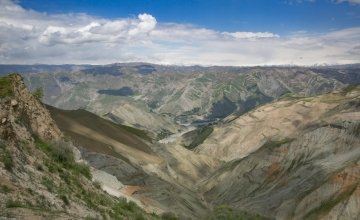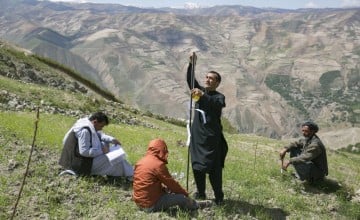
Read our 2023 annual report

Knowledge Hub
Vast areas of northern Afghanistan are on the move, literally. As the glaciers of the Hindu Kush begin to disappear and the mountain snows melt faster and earlier, the people below are facing a major crisis.
It's getting warmer
The average temperature in Afghanistan has increased by more than 1.667 °C since 1950… and it’s getting warmer. While you’d think this might be welcome news for subsistence farmers in the chilly north, the U.N. says it has “potentially disastrous results for agriculture, food security, and nutrition.”
The topography of Badakhshan and Takkar provinces is spectacular at every turn – mountains, cliffs, plateaus, and valleys abound, with rivers, gorges, and ravines transecting the rocky landscape. One thing you won’t see much of here, however, is trees.

The highlands below the treeline have been continuously stripped of their natural forestry, as farmers clear land and isolated communities cut wood for fuel and construction. Bald, exposed hillsides are unable to withstand the annual snowmelt, and every gradient is crisscrossed with the scars of erosion. Below, vast rocky floodbeds have formed — dry and barren during the summer months and a gushing, tumbling, impassable, torrent of boulders, gravel, and sediment during the spring.
These mountains are slowly disappearing.
A tale of two villages
In many highland communities, you’ll find a new and an “old” village, the latter being little more than a collection of battered, overgrown hulks. “There were nine of us living in this house… seven of them were children,” Cuhofran says, squatting amid the ruins of his former home.


We were very badly affected... and still are
This a place where people survive. The growing season is short, winter is both long and harsh, and hunger is a constant. Many communities are cut off for as much as six months of the year and margins are slim. Concern Worldwide have been working here for 20 years, and for the past decade much of that work has involved environmental protection — or “watershed management” as the engineers like to call it.
Managing the environment
It’s a hard sell — you really have to be persuasive and use evidence to make your case,” according to Concern’s program director, Gerry Ganaba. High on a steep hillside, he’s visiting a team who are busy measuring gradients, annotating locations, and hammering long metal rods into the rocky earth. “We’re measuring the exact amount that the land is degrading over the course of 12 months, to show farmers the difference between managed and un-managed ground,” he says.

Watershed management involves a lot of work — digging trenches, building giant rock walls, installing check-dams, planting bushes and trees, fencing off fragile areas… “It’s no joke,” Gerry admits, “so it has to be worth their while.”
The proof, they say, is in the pudding, and 10 slow, arduous, miles away lies another village,in the lee of another steep hill. “The watershed project saved our lives,” Hayatullah says,looking upwards, “it is wealth for us.” A leader is his community, he explains how homes andlivelihoods were constantly threatened by flash flooding and landslides. “Over 70 families were in danger, and many had to abandon their homes.”
The watershed project saved our lives
With advice and resources provided by Concern engineers, local people built a series of gabion walls (box or cylinder structures for a wall which can then be filled with rocks and stones, or even sand or dirt) to divert much of the floodwater and set about rehabilitating the hillsides — using both new methods and their own local solutions. 2,500 almond, peach, and silver birch trees were planted in trenches, and the grass was allowed to grow un-grazed. “We even hired a guard to protect the area,” according to Hayaullah. Today, the valley floor has transformed, as families return and build houses and gardens on land that was once ravaged by landslides.

And a bonus of the project is that each family gets a share of the harvest from the trees, to eat or sell for extra income. Now, the community development committee has set its sights on another water-based project —a micro hydro-power plant, to harness the flow of mountain water for electricity. Currently, there is no power here, except for privately owned generators.
“Out here, we can’t do a lot to stop climate change,” Gerry Ganaba reflects, “but we can certainly help people cope with the effects and become a little more resilient.”
Keep updated
Follow us on Instagram and keep up to date with all of our work in Afghanistan.





